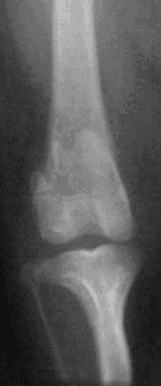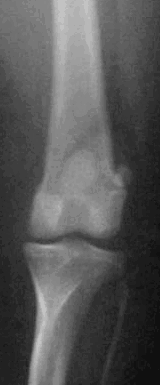The medial luxating patella, commonly called a trick knee, is an extremely common problem in toy-breed dogs. An owner typically notices a little skip in the dog’s step. The dog may even run on three legs, holding one hind leg up, and then miraculously be back on four legs as if nothing has happened.

X-ray of a dog with a medial luxating patella (on left side)and a normal knee (right side). Photo courtesy of Dr. Wendy Brooks
In fact, something has happened: the kneecap (patella) has slipped out of the smooth groove in which it normally rides up and down. It has slipped medially, which is to say towards the opposite leg, as opposed to laterally, which would be away from the dog entirely. With the patella dislocated (or luxated) medially, the knee cannot extend properly and stays bent. With luck, the patient will be able to slip the kneecap back where it belongs and be back to normal in only a few steps. For some dogs, getting a kneecap back where it belongs and normal extension of the rear leg is a mere dream only attainable with surgical correction.
Approximately 50 percent of affected dogs have both knees involved, while the other 50 percent have only one knee involved.
Luxating Patella Radiograph

Knee with medial luxating patella. Instead of riding up and down normal groove (yellow arrow) patella is off to the side (yellow circle). Photo courtesy of Dr. Wendy Brooks
Which Dogs Need Correction?
Medial patellar luxations are graded to assess severity.
Grade I: The kneecap can be moved out of place manually but will fall back into its natural position once the manipulator lets go. Treatment for this form is rarely needed.
Grade 2: The kneecap occasionally slips out of its groove, spontaneously creating an intermittent lameness. The kneecap will go back in place on its own. Whether or not it needs surgery depends on several factors: how often lameness is a problem, how long lameness lasts when it is a problem. Another reason to proceed with surgical intervention is for prevention. If the ridge of bone on the inside of the knee wears down, the Grade 2 will progress to Grade 3. This progression can be prevented with surgery.
Grade 3: The patella is out of place all the time but can be manipulated back into its normal position manually (though it will not stay there). At this point, the dog may seem to crouch or slant down in the rear. Lameness or rear weakness may be persistent. The dog may have a bow-legged appearance. These patients should have knee surgery to correct these problems.
Grade 4: The patella is out of place all the time, and no amount of manipulation can return it to its proper place. Such a dog has extreme difficulty extending his knees and walks with his knees bent virtually all the time in a somewhat crouched position. In this situation, the rotation in the long bones accompanying the luxation will interfere with surgical correction, and total resolution of the lameness may not be possible. Surgery is definitely in order, though success is somewhat variable as this is a very advanced situation.
When a kneecap is out of place, the entire weight-bearing stress of the rear leg is altered, which, in time, leads to changes in the hips, long bones, and ultimately, arthritis. How severe the changes are depends on how severe the luxation is (i.e., the grade as described above) and how long that degree of luxation has been going on. In time, the legs will actually turn outward with its muscles turning inward, making the dog bow-legged. The luxation is not considered a painful condition, but after enough time and conformational change, arthritis sets in, which is indeed painful.
- Dogs with Grade I luxations do not require surgical repair. Often they can be managed with weight control and periodic anti-inflammatory medications.
- Grade 2 dogs may benefit from surgery, and the owner is often called upon to judge how big a problem the lameness is.
- Dogs with Grade 3 or 4 disease definitely should have surgery.
This surgery is a procedure that not all veterinarians are comfortable performing. Discuss with your veterinarian whether a referral to a specialist would be best for you and your pet.
What Surgical Procedures Are Available?

Radiograph of a dog with a normal knee. Photo courtesy of MarVistaVet
Lateral Imbrication (also called Lateral Reinforcement)
This procedure alone may be adequate for a mild case but is often used as an adjunctive procedure to supplement one of the other surgeries. When the patella slips out of its groove, the joint capsule surrounding it is stretched to allow this motion. Imbrication simply involves taking a tuck in the joint capsule. The tightened joint capsule does not allow for the slipping of the kneecap and the kneecap is confined to its proper groove.
Trochlear Modification
The patella rides in a groove at the bottom of the femur (thigh bone). In toy breed dogs this groove is shallow, which allows the patella to slip. If the groove is deepened, the patella stays where it belongs. The normal groove in the femur is lined by slippery lubricated cartilage, called hyaline cartilage. This cartilage is peeled or cut away, the bone underneath is sliced out to form a deeper groove, and the cartilage is replaced. Techniques that do not preserve the original cartilage are no longer recommended.
Tibial Crest Transposition (also called Tibial Tuberosity Transposition)
If the knock-kneed conformation has already started to set in, the tibias (or leg bones) will have rotated. In particular, the crest on the tibia where the thigh muscle (the quadriceps femoris) attaches may have migrated inward. If this is the case, the crest will have to be removed and pinned back where it belongs to straighten out the leg. Severe rotation of the tibias may involve actually cutting through the entire bone and de-rotating it back into place.
The Ridgestop Implant (New)
The Ridgestop implant is a small curved plate that essentially adds height to the ridge of bone on the inside of the knee. By making this area larger, the kneecap becomes unable to slip over it. This technique can be used as a sole solution for Grade 2 luxations or as an adjunct to the other surgical repairs.
Should both Knees be Repaired at the Same Time or Should They Be Staged?
Some surgeons feel that doing one leg at a time, eight weeks or more apart, is beneficial as the patient will have one good rear leg upon which to walk. If the patient is very young (under age one year) it may be a good idea to do both legs at the same time so as to prevent conformational problems in the leg that is not operated on first. Every surgeon will have their own philosophy on whether or not to do both legs at once. Consult your surgeon about the pros and cons and decide.
Post-operative Care
If imbrication was the only procedure, expect three to four weeks of confinement to a large crate or pen, during which the pet will need to be carried outside for bathroom functions.
If any of the other procedures above were utilized, expect more like six to eight weeks of confinement depending on the surgeon’s preference. During this time easy walking (no running or jumping) is helpful. The dog should be using the leg by two weeks post-operatively though some dogs must be retrained to use the leg after surgery. Physical therapy is in order if the dog is not using the leg after one month.
The American College of Veterinary Surgeons has additional information on patellar luxation.